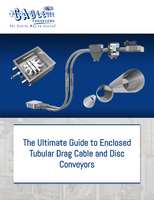Industrial Models, Inc. Increases Productivity, Reduces Overtime Costs and Improves Competitiveness with New RPT Router Trimming System
Share:
CHALLENGE
Industrial Models, Inc., located in Gainesville, Texas, specializes in the manufacture of
vacuum-formed plastics, open mold fiberglass and resin transfer-molded parts primarily
in the heavy trucking industry. Prior to working with RPT, the company used manual
processes to trim all vacuum-formed parts.
Industrial Models needed an automated system that would provide a cost-effective,
reliable and safe way to trim parts for the vacuum-formed process. The company hoped
to become more competitive in the market by reducing defects, increasing production
capacity and improving overall quality by automating the trimming process. The
increase in production would be immediate because some parts required multiple setups
and fixtures to complete the trimming. This would result in an immediate time
savings.
Solution
The 2004 Society of Plastics Engineering Thermoforming Conference helped to provide
a solution. Industrial Models visited several vendors at the conference and decided that
the RoboTrim(TM) RT-1000 system provided by Robotic Production Technology (RPT)
appeared to be faster and more flexible as compared to the CNC systems they
investigated.
"With our hand trimming, we had parts that required six or seven fixtures. Hard to trim
parts with complicated set-ups are eliminated since only one trim fixture is necessary
with this system," said Ben Lyson, Product Manager for Industrial Models. "The RPT
RoboTrim RT-1000 eliminates that waste. Our new system is safer, faster, more
accurate and more repeatable."
How the RPT RoboTrim RT-1000 system works:
o The RPT RoboTrim RT-1000 system is equipped with a FANUC-based
AccuTrim(TM) R-44 robot.
o There are two part fixtures, one located on each side of a two position rotating
table. One side of the table is inside the enclosure with the robot, the other is
outside the enclosure for operator access.
o Part or parts (depending on size) are placed on "A" side fixture which is then
rotated into trimming cell
o While a part is being trimmed inside the cell, another part can be loaded onto the
"B" side of the cell. There are safety interlocks to prevent the table from rotating
while the operator is loading the fixture.
o When the "A" side part is complete and the loading station is clear, the wall
rotates, presenting the "B" side part to the robot for trimming.
RPT needed to make the trimming system safe and easy for the employees to operate,
while ensuring that the employee would match the correct program to the correct fixture
being placed on the cell. Industrial Models also required a quick and easy set-up. The
two-position servo table allows the operator to load and unload parts while the robotic
trimming takes place inside the enclosed cell. This greatly improved the productivity of
the manufacturing process as compared to CNC systems or manual trimming
operations. Industrial Models found that their larger parts could also be cut with RPT's
standard RoboTrim RT-1000 unit.
Additional system features
o When the fixture is placed on the cell, a tag reader identifies the correct program
for that particular fixture.
o Each fixture is lightweight enough for two employees to lift and set it on the cell.
Two alignment pins set the fixture in the correct location. This operation can take
place while a part is being trimmed inside the cell because set-up time takes
place in seconds.
o The trimming takes place inside a protected enclosure to further ensure safety.
"We didn't know how simple it would be to use the system. The tag reader tells the
whole story and makes it a Poke-Yoke process. All the employee needs to do is push a
button," said Lyson. "The more I learned about the RT-1000, the happier I was. The
unit ran like clockwork right from set-up."
RPT's enclosed RoboTrim(TM) RT-1000 router trimming system accommodates parts of all
different sizes and shapes. Industrial Models currently trims 20 different parts - from
small parts up to the maximum that the system can handle (See Table 1). The company
plans to eventually cut more than 39 different parts on the system. Industrial Models
started programming the high volume, difficult to trim parts first. Eventually, the
company will move to the low volume easy-to-trim parts. Any new products are quoted
using the robotic system to handle the trimming.
Table 1:
System can trim parts with the various dimensions
Length Depth Height (Z)
60" 36" 18"
70" 12" 12"
88" 12" 8"
The RoboTrim system included RPT's RouterVacTM system, a new vacuum system used
to hold parts in place during trimming and to remove waste particles from the cutting
area. The RouterVacTM system has an integrated waste hopper for collecting debris that
a forklift driver can remove for disposal. The RouterVac is very easy to maintain.
The system also included RPT and FANUC Robotics' jointly developed Accuracy
Enhancement software to help accommodate the variance in parts. These accuracy
enhancement tools allow users to quickly and accurately set-up and maintain the key
components that are required to achieve process repeatability. In addition, users gain the
ability to transfer programs from one robot system to another with minimal touch-up of
programmed points, further saving time and simplifying program maintenance.
Key features of the Accuracy Enhancement tools are the ability to automatically realign
the router spindle in less than one minute. The software also gives the robot the ability to
automatically locate the part holding fixture and orient the robot program to that fixture's
exact position. This software ensures the robot spindle is aligned and that the exact fixture
location is known before the first part is ever run.
RESULTS
Industrial Models installed the RoboTrim router trimming system in May 2005. Since
that time, the company has achieved the target results from the RoboTrim router
trimming system -
- Production increased by 60 percent
- The trimming system is safer
- Increased part repeatability and quality
- The company is more cost competitive when quoting for new business
- The company reduced overtime by 12 percent
- Industrial Models could process several part styles while minimizing
floorspace.
The robotic system helped to make the trimming process much less complicated and
Industrial Models more cost competitive when bidding on new business. Industrial
Models is currently utilizing 50 percent of available machine capacity and plans to
program additional parts to take full advantage of the extra available machine time.
"We lost some business when we quoted complicated, hard-to-fixture parts with the
hand trimming process. In the future, we will be more cost effective and win more bids
since our process is predictable now," said Lyson. "We know exactly how long it will
take since we can predict cycle times and throughput more accurately. Our trim time
won't depend on how an employee feels that day."
The new system also helped to improve quality since the hand trimming operation may
vary or required holes could be omitted by the operator.
"With our end customers, it has helped us procure more business because the customer
knows they will receive consistent, repeatable product that is defect-free," said Lyson.
"The robotic system has been received very well."
Industrial Models moved some employees to the trimming area in the open mold
fiberglass part of the facility since less labor was needed in the trimming for vacuum
formed parts. This helped to reduce the amount of overtime paid by the company by 12
percent.
Due to the success of the system, Industrial Models, Inc. is in the process of adding a
second trim cell in the near future.




